Mechanical Performance and Strengthening Mechanism of Polymer Concretes Reinforced with Carbon Nanofiber and Epoxy Resin
Abstract
:1. Introduction
2. Materials and Methods
2.1. Raw Materials
2.2. Preparation of Polymer-Modified Concrete
- (1)
- Proportional design of polymer-modified concrete
- (2)
- Fabrication of polymer-modified concrete
2.3. Characterization
- (1)
- Compressive strength
- (2)
- Flexural strength
- (3)
- Tensile strength
- (4)
- Resistance to chloride ion permeability
- (5)
- Frost resistance
- (6)
- Crystal structure and microscopic morphology analysis
3. Results and Discussion
3.1. XRD Analyses of WBE-Modified Concrete
3.2. Mechanical Properties Testing of Epoxy Resin Modified Concrete
3.3. Durability Testing of WBE-Modified Concrete
4. Conclusions
- (1)
- The addition of epoxy resin WBE to cement raw materials resulted in an increasing consumption of C3S and C2S, accelerating the formation of CH and other hydration products, and enhancing the interconnectivity between the hydration products. Finally, a significant reduction in the number of pores and cracks was realized. The most compact concrete structure and minimal cracks were achieved with a WBE ratio of 10%.
- (2)
- Concrete mixed with WBE exhibited a decreasing trend in compressive strength and elasticity modulus and a rising trend in Poisson’s ratio at all curing ages. The fiber component revealed no remarkable effect on Poisson’s ratio. An increase in the WBE content added showed a downward trend in the elasticity modulus for the WBE-modified concrete. As a critical factor, WBE enhanced the ductility of the concrete, while the fiber component exhibited a more obvious impact on the crack resistance and toughening with the cooperation of WBE.
- (3)
- The flexural strength and flexural–compression ratio of the WBE-modified concrete showed an ascending and then descending trend with the addition of WBE. The maximum flexural strength of concrete was observed with 10% WBE content, attributable to the incorporation of aggregate and hydration products to form an elastic organic–inorganic composite mesh structure in virtue of a WBE film. Beyond 10% WBE, the enhancement in the flexural capacity was reduced due to defects and the stress concentration point of WBE. The improved interphase forces within the concrete further strengthened the flexibility and crack resistance of the modified concrete.
- (4)
- The lowest value for the chloride ion diffusion coefficient of concrete was obtained with 2.2 × 10−12 m2/s at 28 days curing time and with a 10% admixture of WBE. The concrete permeability was classified as RCM-III to RCM-IV.
- (5)
- Due to the improvement in the freeze–thaw cycle properties of WBE with carbon fiber incorporation, a lowest mass loss rate of 0.21% and a maximum value of relative dynamic elastic modulus of 94.86% under 300 freeze–thaw cycles were achieved for the W10CF sample. The “cracking effect” of the carbon fiber was more pronounced, whereas the “filling effect” of the WBE was more noticeable. WBE exhibited a favorable optimization effect on the pore structure of concrete, resulting in a reduced number of cracks and gaps, increased densities, and remarkable improvements in frost resistance.
- (6)
- The impermeability, frost resistance, and volume stability of the WBE-modified concrete composites were positively correlated with the WBE amount. Carbon fiber had a negative effect on the permeability of the concrete, but no notable influence on its frost resistance and volume stability.
- (7)
- Fiber- and resin-modified concrete has a wide range of applications in practical applications such as building structures, road engineering, bridge construction, etc., with the advantages of improved structural performance, enhanced durability, and reduced maintenance costs. Also, strict quality control and testing are required to ensure that the quality and performance of the modified concrete is in accordance with the requirements.
Author Contributions
Funding
Institutional Review Board Statement
Informed Consent Statement
Data Availability Statement
Conflicts of Interest
References
- Zheng, Y.X.; Zhang, Y.; Zhuo, J.B.; Zhang, Y.M.; Wan, C. A review of the mechanical properties and durability of basalt fiber-reinforced concrete. Constr. Build. Mater. 2022, 359, 129360. [Google Scholar] [CrossRef]
- Shao, R.Z.; Wu, C.Q.; Li, J. A comprehensive review on dry concrete: Application, raw material, preparation, mechanical, smart and durability performance. J. Build. Eng. 2022, 55, 104676. [Google Scholar] [CrossRef]
- Yi, J.; Wang, L.; Ma, L.J.; Zhang, Q.C.; Zhang, J.W.; Chi, J.S. Experimental study on basic mechanical properties of PVA fiber-reinforced coral cement-based composites. Materials 2023, 16, 2914. [Google Scholar] [CrossRef]
- Golewski, G.L. Concrete composites based on quaternary blended cements with a reduced width of initial microcracks. Appl. Sci. 2023, 13, 7338. [Google Scholar] [CrossRef]
- Zhang, T.H.; Mahdi, M.; Issa, M.; Xu, C.X.; Ozevin, D. Experimental study on monitoring damage progression of basalt-FRP reinforced concrete slabs using acoustic emission and machine learning. Sensors 2023, 23, 8356. [Google Scholar] [CrossRef] [PubMed]
- Hou, D.S.; Chen, D.D.; Wang, X.P.; Wu, D.; Ma, H.Y.; Hu, X.X.; Zhang, Y.; Wang, P.; Yu, R. RSM-based modelling and optimization of magnesium phosphate cement-based rapid-repair materials. Constr. Build. Mater. 2020, 263, 120190. [Google Scholar] [CrossRef]
- Li, J.S.; Zhang, W.B.; Cao, Y. Laboratory evaluation of magnesium phosphate cement paste and mortar for rapid repair of cement concrete pavement. Constr. Build. Mater. 2014, 58, 122–128. [Google Scholar] [CrossRef]
- Haruna, S.I.; Zhu, H.; Jiang, W.L.X.; Shao, J.W. Evaluation of impact resistance properties of polyurethane-based polymer concrete for the repair of runway subjected to repeated drop-weight impact test. Constr. Build. Mater. 2014, 309, 125152. [Google Scholar] [CrossRef]
- Jung, K.C.; Roh, I.T.; Chang, S.H. Evaluation of mechanical properties of polymer concretes for the rapid repair of runways. Compos. B Eng. 2014, 58, 352–360. [Google Scholar] [CrossRef]
- Shi, C.; Zou, X.W.; Yang, L.; Wang, P.; Niu, M.D. Influence of humidity on the mechanical properties of polymer-modified cement-based repair materials. Constr. Build. Mater. 2020, 261, 119928. [Google Scholar] [CrossRef]
- Liu, F.; Pan, B.F.; Zhou, C.J. Experimental study on a novel modified magnesium phosphate cement mortar used for rapid repair of portland cement concrete pavement in seasonally frozen areas. J. Mater. Civ. Eng. 2022, 34, 04021483. [Google Scholar] [CrossRef]
- Aykac1, S.; Kalkan, I.; Aff, S.E.; Aykac, B.; Karahan, S.; Kaya, S. Strengthening and repair of reinforced concrete beams using external steel plates. J. Struct. Eng. 2013, 139, 929–939. [Google Scholar] [CrossRef]
- Tayeh, B.A.; Bakar, B.H.A.; Johari, M.A.M. Characterization of the interfacial bond between old concrete substrate and ultrahigh performance fiber concrete repair composite. Mater. Struct. 2013, 46, 743–753. [Google Scholar] [CrossRef]
- Wang, Y.M.; Wang, C.D.; Zhou, S.H.; Liu, K.W. Influence of cationic epoxy resin type on electrophoretic deposition effect on repair of rust-cracked reinforced concrete. Constr. Build. Mater. 2022, 324, 126714. [Google Scholar] [CrossRef]
- Hang, Z.Y.; He, K.S.; Zhao, W.; Yu, Y. Fracture properties of a concrete-epoxy mortar interface with precoating treatment applied through image correlation technology. Constr. Build. Mater. 2023, 370, 130640. [Google Scholar] [CrossRef]
- Hawary, M.E.; Khaiat, H.A.; Fereig, S. Performance of epoxy-repaired concrete in a marine environment. Cem. Concr. Res. 2000, 30, 259–266. [Google Scholar] [CrossRef]
- Pang, B.; Jin, Z.Q.; Zhang, Y.S.; Xu, L.; Li, M.Y.; Wang, C.C.; Zhang, Y.; Yang, Y.; Zhao, P.; Bi, J.X.; et al. Ultraductile waterborne epoxy-concrete composite repair material: Epoxy-fiber synergistic effect on flexural and tensile performance. Cem. Concr. Res. 2022, 129, 104463. [Google Scholar] [CrossRef]
- Wang, C.D.; Wang, Y.M.; Liu, K.W.; Zhou, S.H. Effect of colloid solution concentration of epoxy resin on properties of rust-cracked reinforced concrete repaired by electrophoretic deposition. Constr. Build. Mater. 2022, 318, 126184. [Google Scholar] [CrossRef]
- Guo, S.Y.; Zhang, X.; Chen, J.Z.; Mou, B.; Shang, H.S.; Wang, P.; Zhang, L.H.; Ren, J. Mechanical and interface bonding properties of epoxy resin reinforced Portland cement repairing mortar. Constr. Build. Mater. 2020, 264, 120715. [Google Scholar] [CrossRef]
- Luo, J.L.; Li, Q.Y.; Zhao, T.J.; Gao, S.; Sun, S.W. Bonding and toughness properties of PVA fibre reinforced aqueous epoxy resin cement repair mortar. Constr. Build. Mater. 2013, 49, 766–771. [Google Scholar] [CrossRef]
- Uzbas, B.; Aydin, A.C. Microstructural analysis of silica fume concrete with scanning electron microscopy and X-Ray diffraction. Eng. Technol. Appl. Sci. 2020, 10, 5845–5850. [Google Scholar] [CrossRef]
- Li, Y.; Guo, Y.C.; Lyu, Z.H.; Wei, X. Investigation of the effect of waterborne epoxy resins on the hydration kinetics and performance of cement blends. Constr. Build. Mater. 2021, 301, 124045. [Google Scholar] [CrossRef]
- Dai, Y.Q.; Yang, R.J.; Xu, C.J.; Mansour, A.A.; Lan, Y.; Peng, Y.; Li, L.; Zeng, Q.; Li, K.F. In-situ μ-XCT characterization of cement-waterborne epoxy resin coalescence. Constr. Build. Mater. 2023, 377, 131161. [Google Scholar] [CrossRef]
- Liu, W.T.; Sun, Y.D.; Meng, X.X.; Qin, Y.Y. Experimental analysis of Nano-SiO2 modified waterborne epoxy resin on the properties and microstructure of cement-based grouting materials. Energy 2023, 268, 126669. [Google Scholar] [CrossRef]
- Byron, D.; Heitman, A.P.; Neves, J.; Souza, P.P.D.; Patricio, P.S.D.O. Evaluation of properties of polymer concrete based on epoxy resin and functionalized carbon nanotubes. Constr. Build. Mater. 2021, 309, 125155. [Google Scholar] [CrossRef]
- Lin, C.H.; Yu, J. Research on improving polymer pervious concrete mechanical strength by adding EVA to UP resin binder material. Constr. Build. Mater. 2022, 359, 129416. [Google Scholar] [CrossRef]
- Akın, M.H.; Polat, R. The effect of vehicle waste tires on the mechanical, hardness and stress-strain properties of polyester-based polymer concretes. Constr. Build. Mater. 2022, 325, 126741. [Google Scholar] [CrossRef]
- Joseph, L.; Chakravarthi, E.K.; Jayanarayanan, K.; Mini, K.M. Nano filler incorporated epoxy based natural hybrid fiber confinement of concrete systems: Effect of fiber layers and nano filler addition. Structures 2023, 51, 320–331. [Google Scholar] [CrossRef]
- Ulu, A.; Tutar, A.I.; Kurklu, A.; Cakir, F. Effect of excessive fiber reinforcement on mechanical properties of chopped glass fiber reinforced polymer concretes. Constr. Build. Mater. 2022, 359, 129486. [Google Scholar] [CrossRef]
- Carrillo, J.; Ramirez, J.; Marriaga, J.L. Modulus of elasticity and Poisson’s ratio of fiber-reinforced concrete in Colombia from ultrasonic pulse velocities. J. Build. Eng. 2019, 23, 18–26. [Google Scholar] [CrossRef]
- Li, K.; Wei, Y.X.; Li, Y.P.; Li, Z.Q.; Zhu, J.T. Flexural behavior of reinforced concrete beams strengthened with high-strength stainless steel wire rope meshes reinforced ECC. Constr. Build. Mater. 2023, 362, 129627. [Google Scholar] [CrossRef]
- Saeed, Y.M.; Aules, W.A.; Rad, F.N.; Raad, A.M. Tensile behavior of FRP anchors made from CFRP ropes epoxy-bonded to uncracked concrete for flexural strengthening of RC columns. Case Stud. Constr. Mater. 2020, 13, e00435. [Google Scholar] [CrossRef]
- Gujar, P.; Hirshikesh, H.; Annabattula, R.K.; Ghosh, P. Structural to interfacial fracture transition in epoxy coated hydrating cement. Constr. Build. Mater. 2021, 310, 125128. [Google Scholar] [CrossRef]
- Li, P.F.; Jiang, Z.S.; An, X.H.; Maekawa, K.; Du, S.L. Time-dependent retardation effect of epoxy latexes on cement hydration: Experiments and multi-component hydration model. Constr. Build. Mater. 2022, 320, 126282. [Google Scholar] [CrossRef]
- Bahraq, A.A.; Obot, I.B.; Osta, M.A.A.; Amoudi, O.S.B.A.; Maslehuddin, M. Molecular-level investigation on the effect of surface moisture on the bonding behavior of cement-epoxy interface. J. Build. Eng. 2022, 61, 105299. [Google Scholar] [CrossRef]
- Zhao, Q.; Zhang, D.X.; Zhao, X.L.; Sharma, S. Modelling damage evolution of carbon fiber-reinforced epoxy polymer composites in seawater sea sand concrete environment. Compos. Sci. Technol. 2021, 215, 108961. [Google Scholar] [CrossRef]
- Hussain, Q.; Ruangrassamee, A.; Tangtermsirikul, S.; Joyklad, P. Behavior of concrete confined with epoxy bonded fiber ropes under axial load. Constr. Build. Mater. 2020, 263, 120093. [Google Scholar] [CrossRef]
- Li, J.l.; Xie, J.H.; Liu, F.; Lu, Z.Y. A critical review and assessment for FRP-concrete bond systems with epoxy resin exposed to chloride environments. Compos. Struct. 2019, 229, 111372. [Google Scholar] [CrossRef]
- Xue, Y.C.; Qian, Z.D. Development and performance evaluation of epoxy asphalt concrete modified with mineral fiber. Constr. Build. Mater. 2016, 102, 378–383. [Google Scholar] [CrossRef]
- Spainhour, L.K.; Wootton, I.A. Corrosion process and abatement in reinforced concrete wrapped by fiber reinforced polymer. Cem. Concr. Res. 2008, 30, 535–543. [Google Scholar] [CrossRef]
- Wang, D.H.; Gong, Q.N.; Yuan, Q.; Luo, S.R. Review of the properties of fiber-reinforced polymer-reinforced seawater-sea sand concrete. J. Mater. Civ. Eng. 2021, 33, 04021285. [Google Scholar] [CrossRef]
- Zheng, W.; Chen, W.G.; Feng, T.; Li, W.Q.; Liu, X.T.; Dong, L.L.; Fu, Y.Q. Enhancing chloride ion penetration resistance into concrete by using graphene oxide reinforced waterborne epoxy coating. Prog. Org. Coat. 2020, 138, 105389. [Google Scholar] [CrossRef]
- Zuo, J.D.; Li, H.B.; Dong, B.Q.; Luo, C.Y.; Chen, D.Z. Mechanical properties and resistance to chloride ion permeability of epoxy emulsion cement mortar reinforced by glass flake. Constr. Build. Mater. 2017, 155, 137–144. [Google Scholar] [CrossRef]
- Yin, S.P.; Jing, L.; Yin, M.T.; Wang, B. Mechanical properties of textile reinforced concrete under chloride wet-dry and freeze-thaw cycle environments. Cem. Concr. Res. 2019, 96, 118–127. [Google Scholar] [CrossRef]
- Mahmoud, F.A.; Mechling, J.M.; Shaban, M. Bond strength of different strengthening systems-Concrete elements under freeze-thaw cycles and salt water immersion exposure. Constr. Build. Mater. 2014, 70, 399–409. [Google Scholar] [CrossRef]
- Ying, G.G.; Song, C.; Ren, J.; Guo, S.Y.; Nie, R.; Zhang, L.H. Mechanical and durability-related performance of graphene/epoxy resin and epoxy resin enhanced OPC mortar. Constr. Build. Mater. 2021, 282, 122644. [Google Scholar] [CrossRef]
- Wang, Y.; Zhang, S.H.; Li, G.X.; Shi, X.M. Effects of alkali-treated recycled carbon fiber on the strength and free drying shrinkage of cementitious mortar. J. Clean. Prod. 2019, 228, 1187–1195. [Google Scholar] [CrossRef]

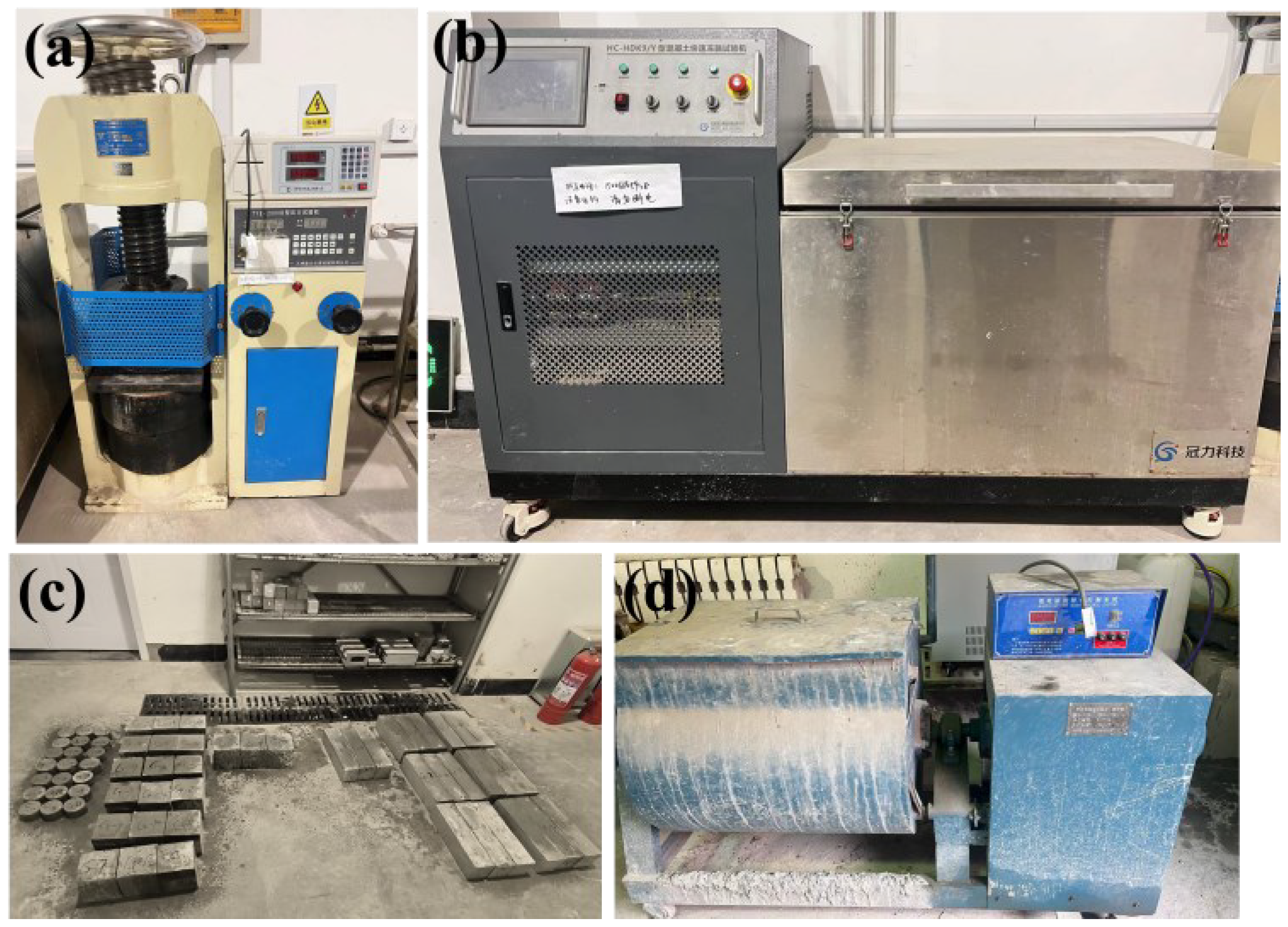
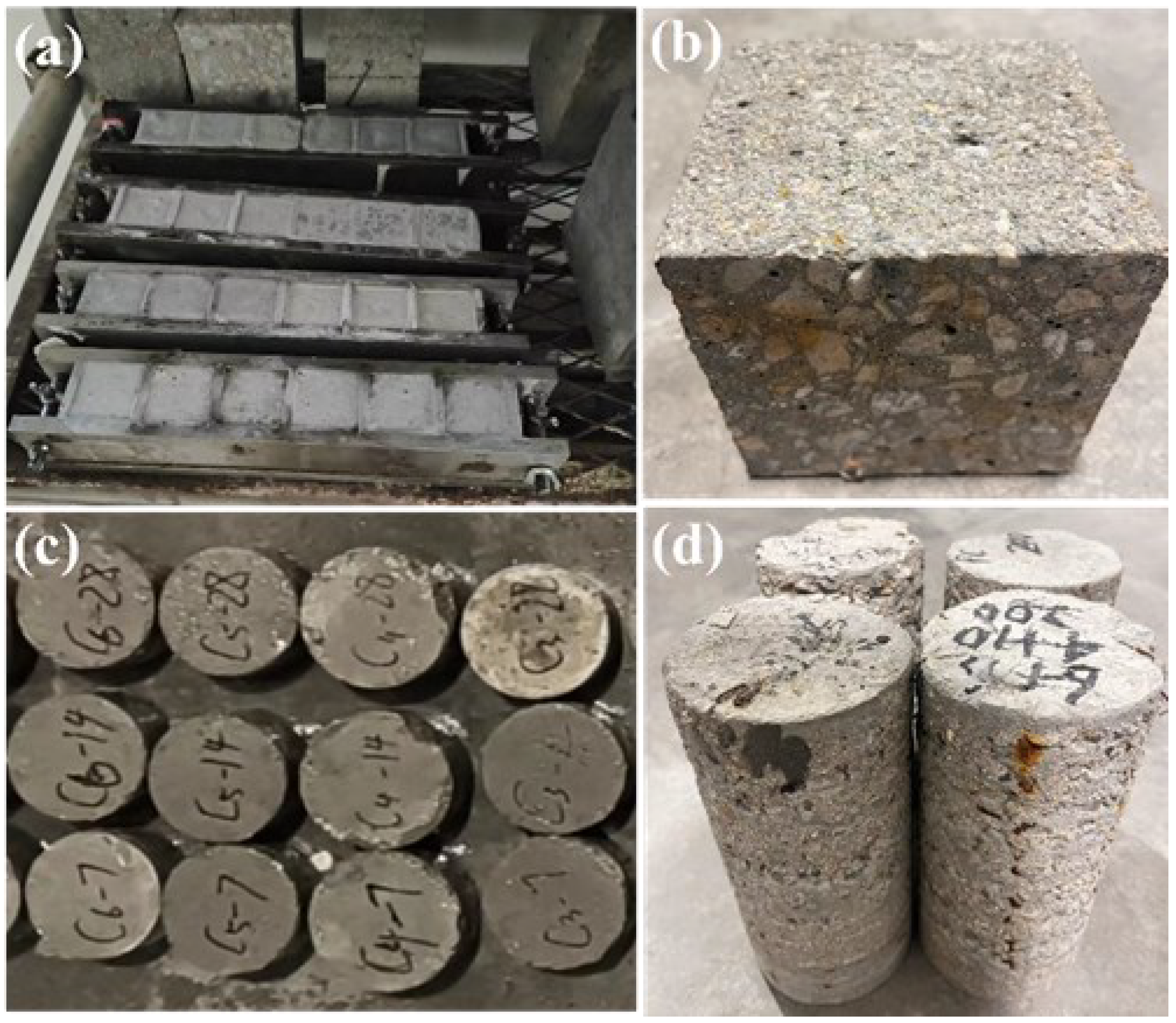
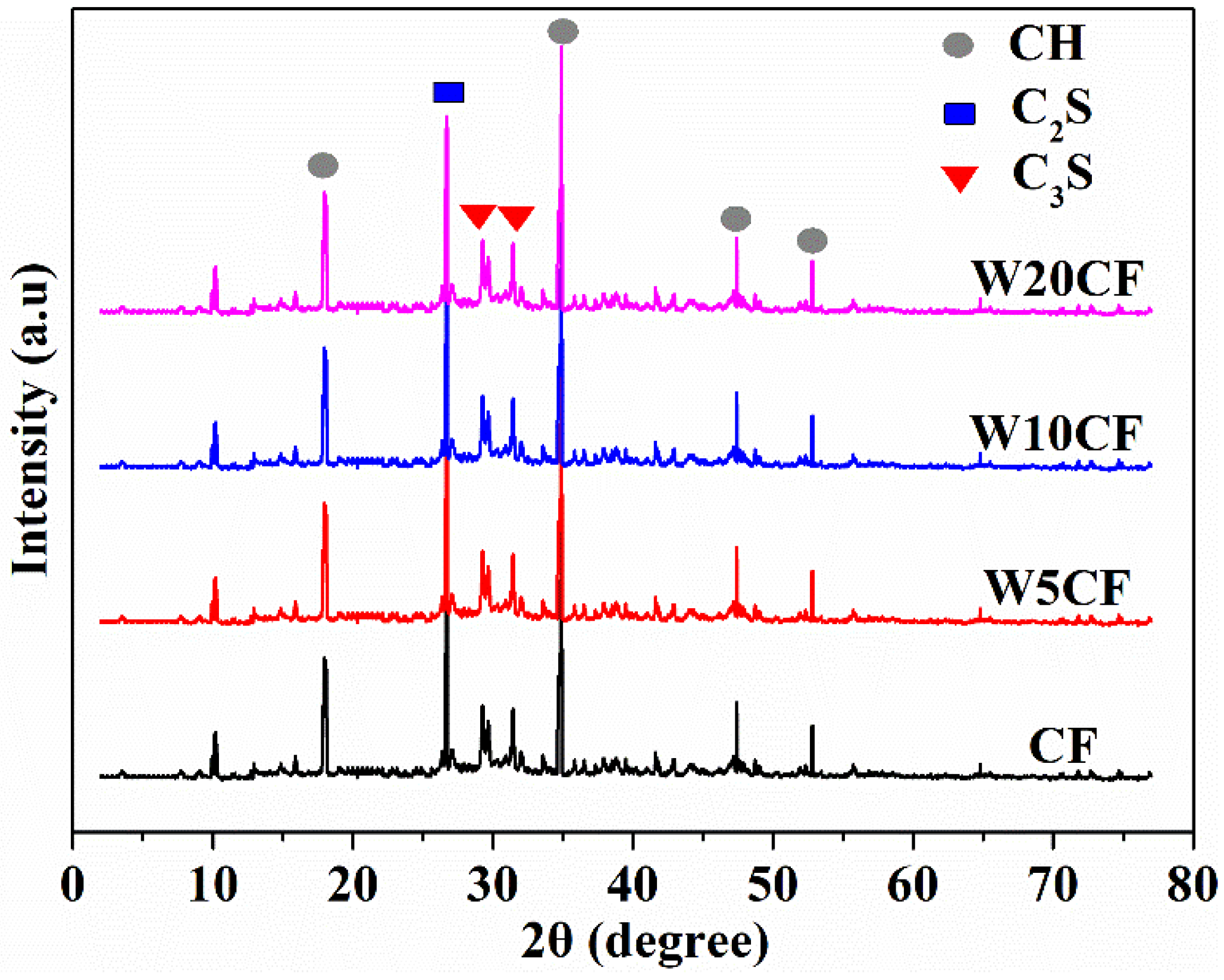

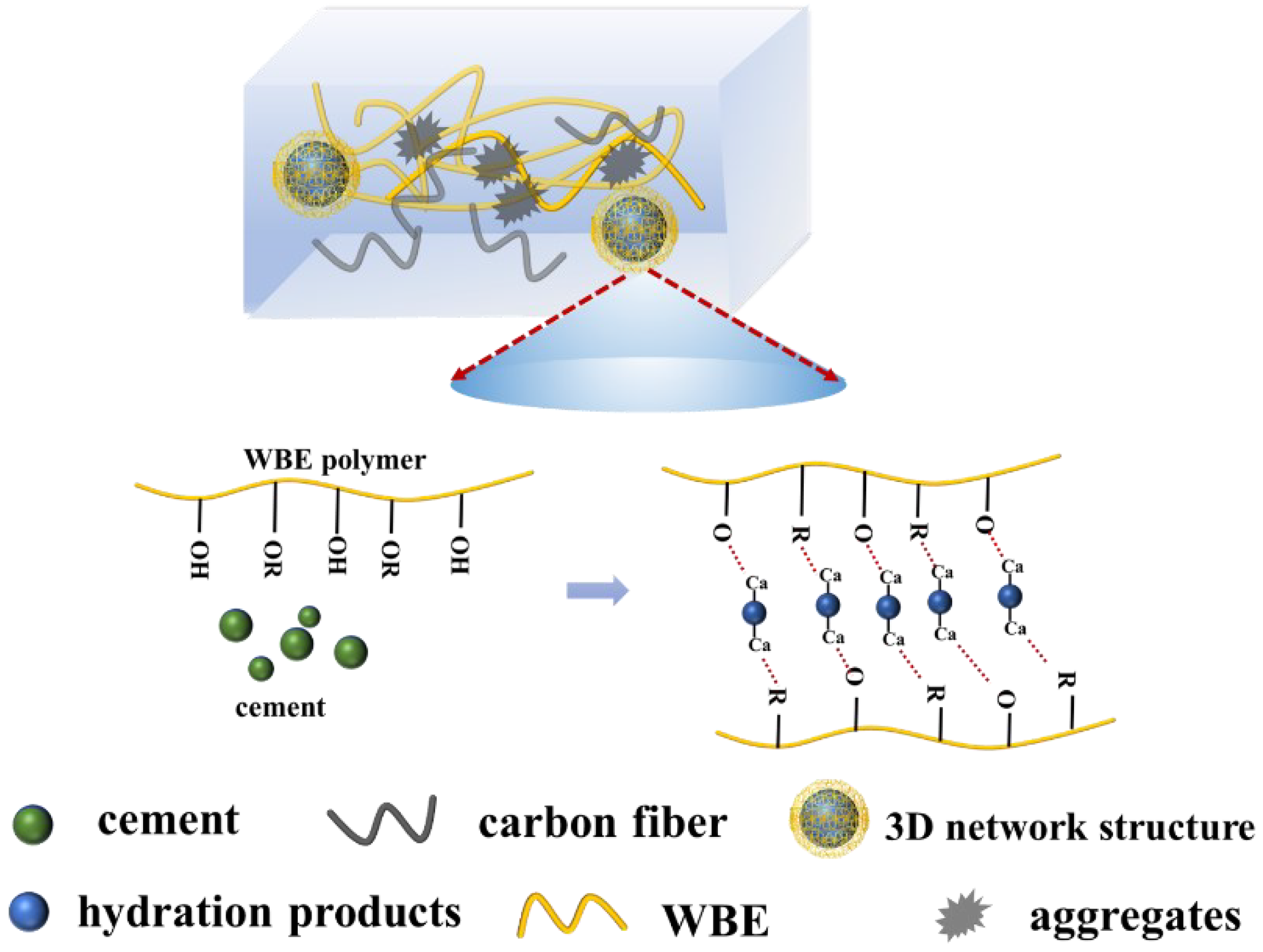
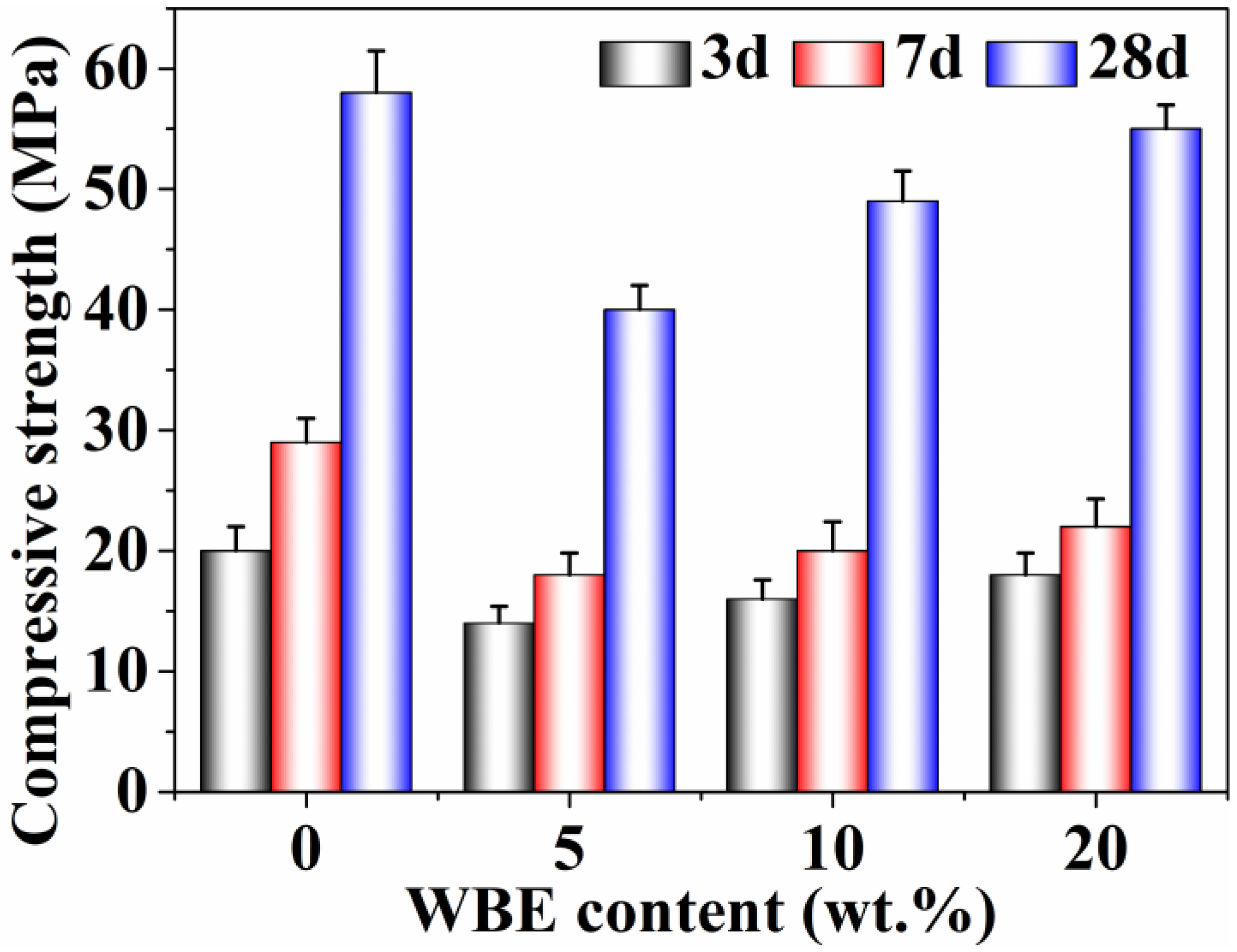
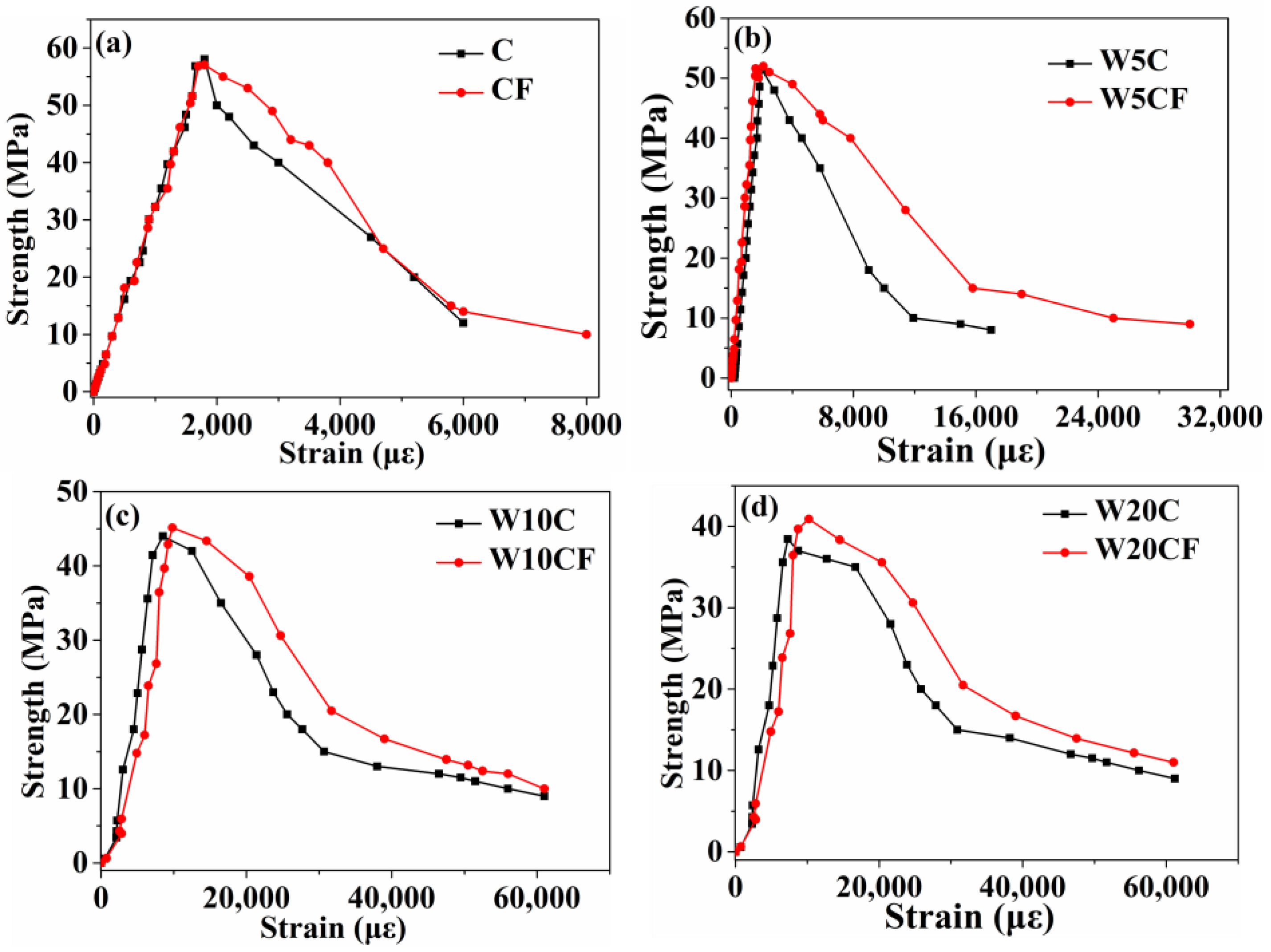
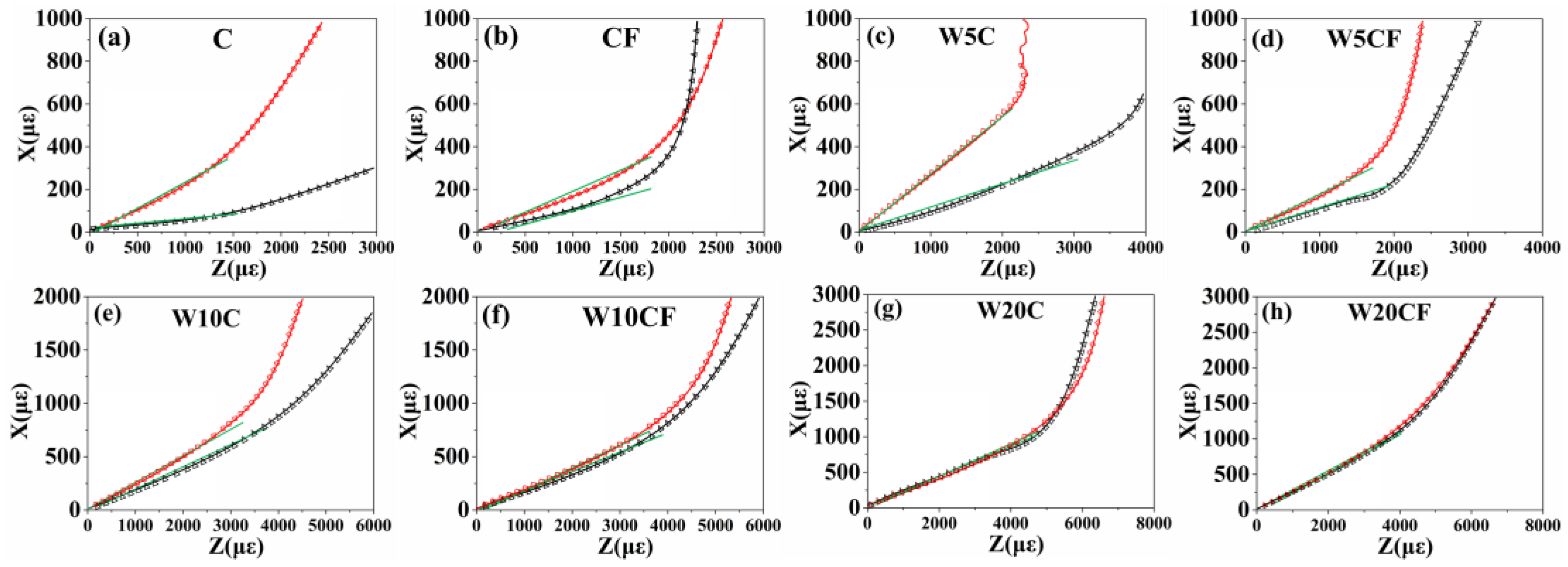
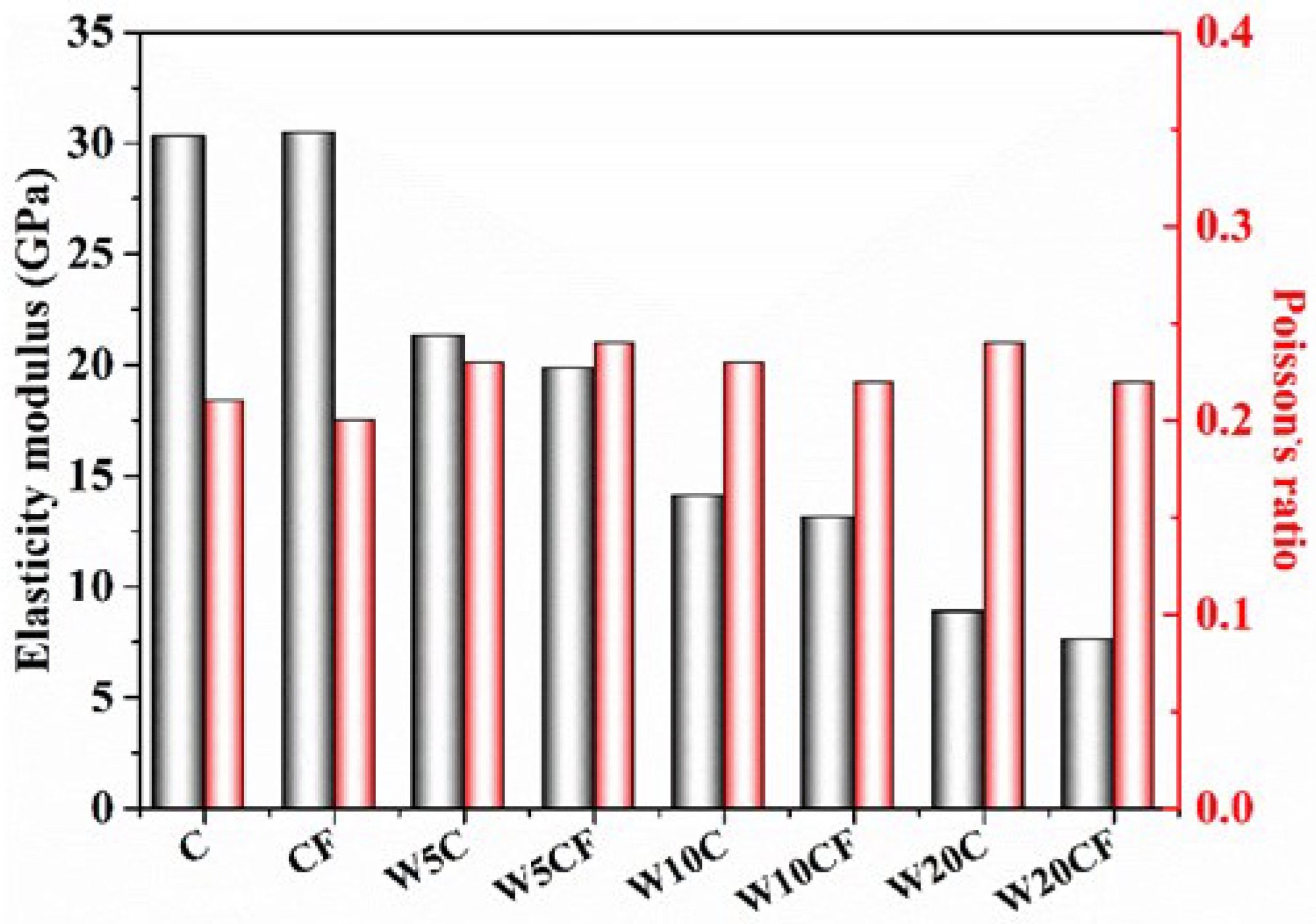
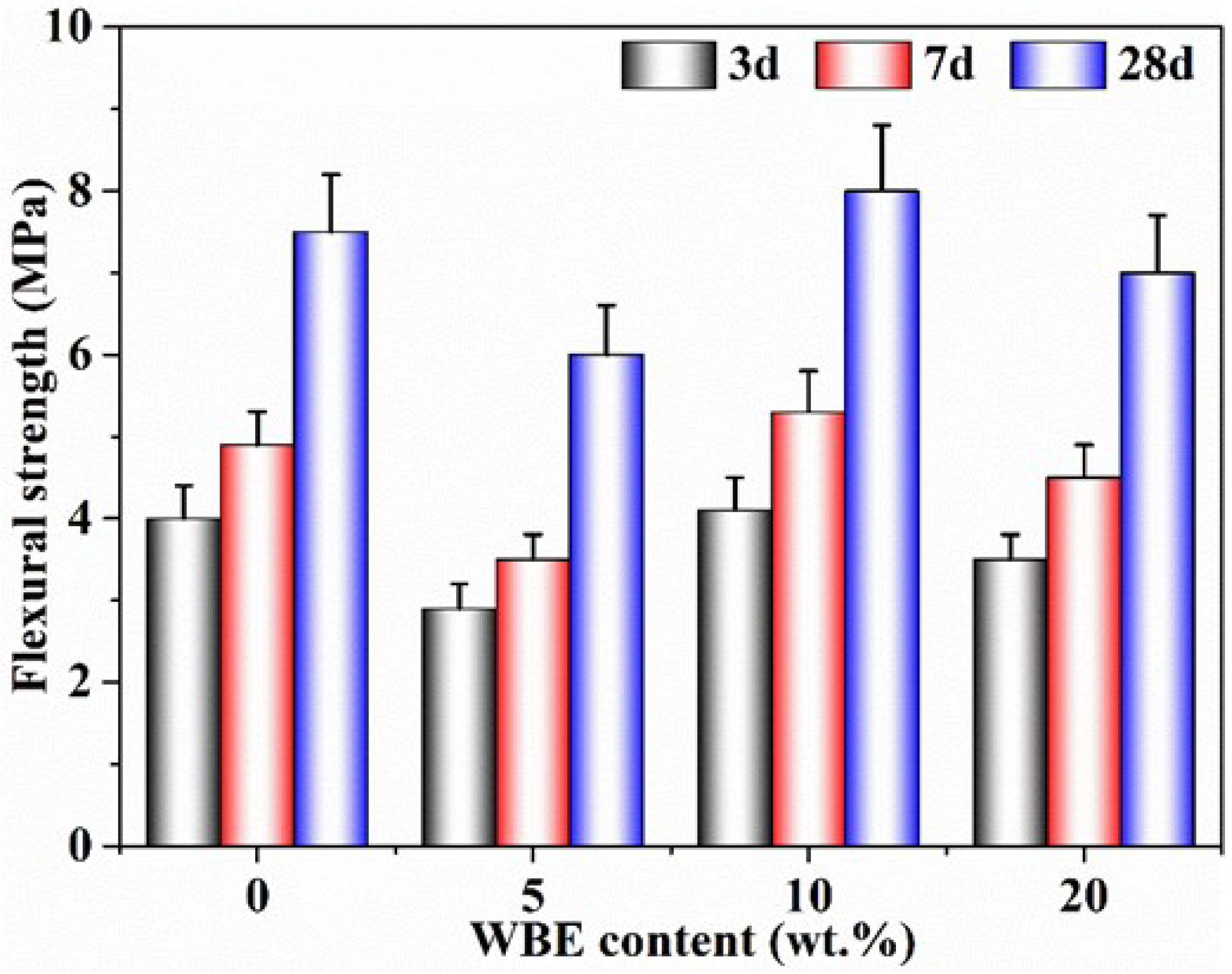
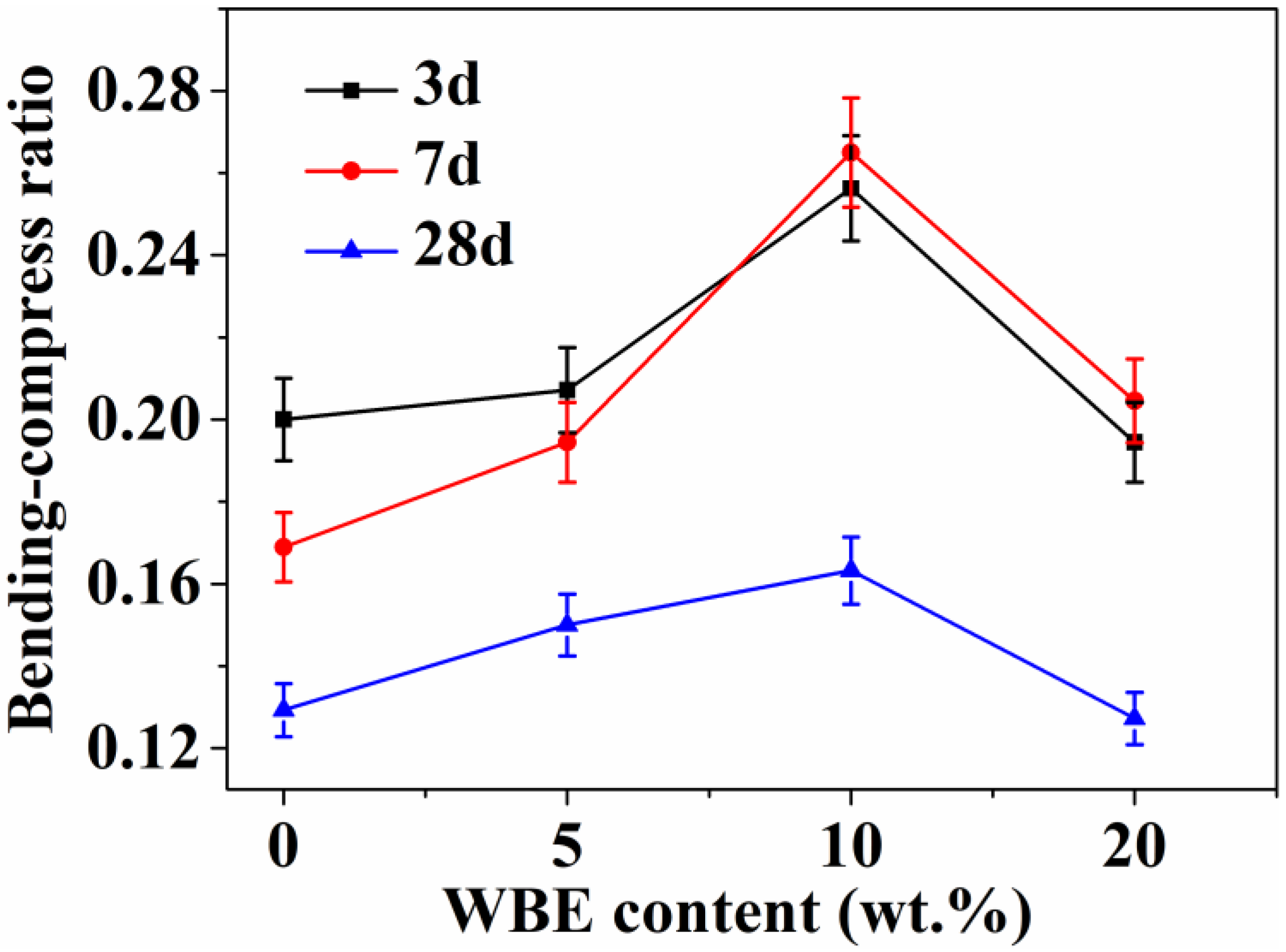
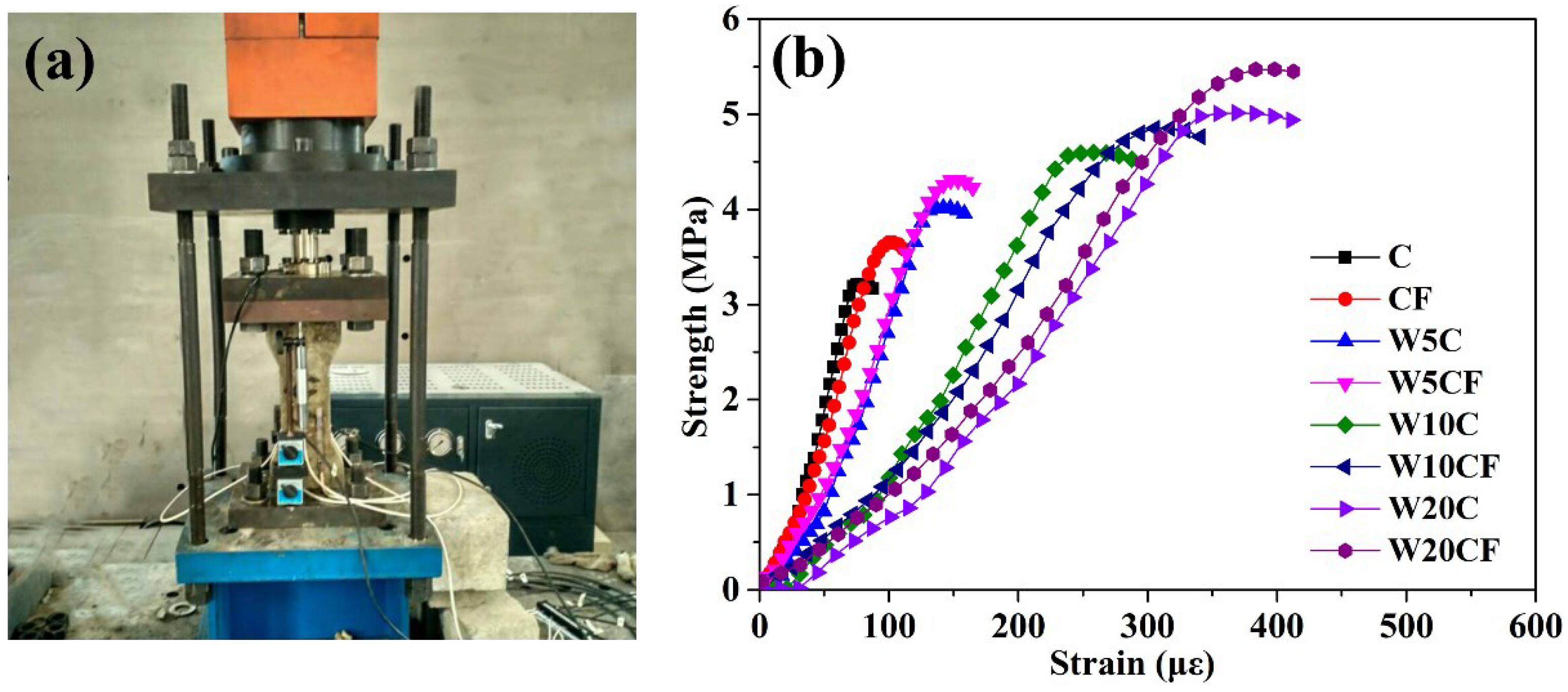

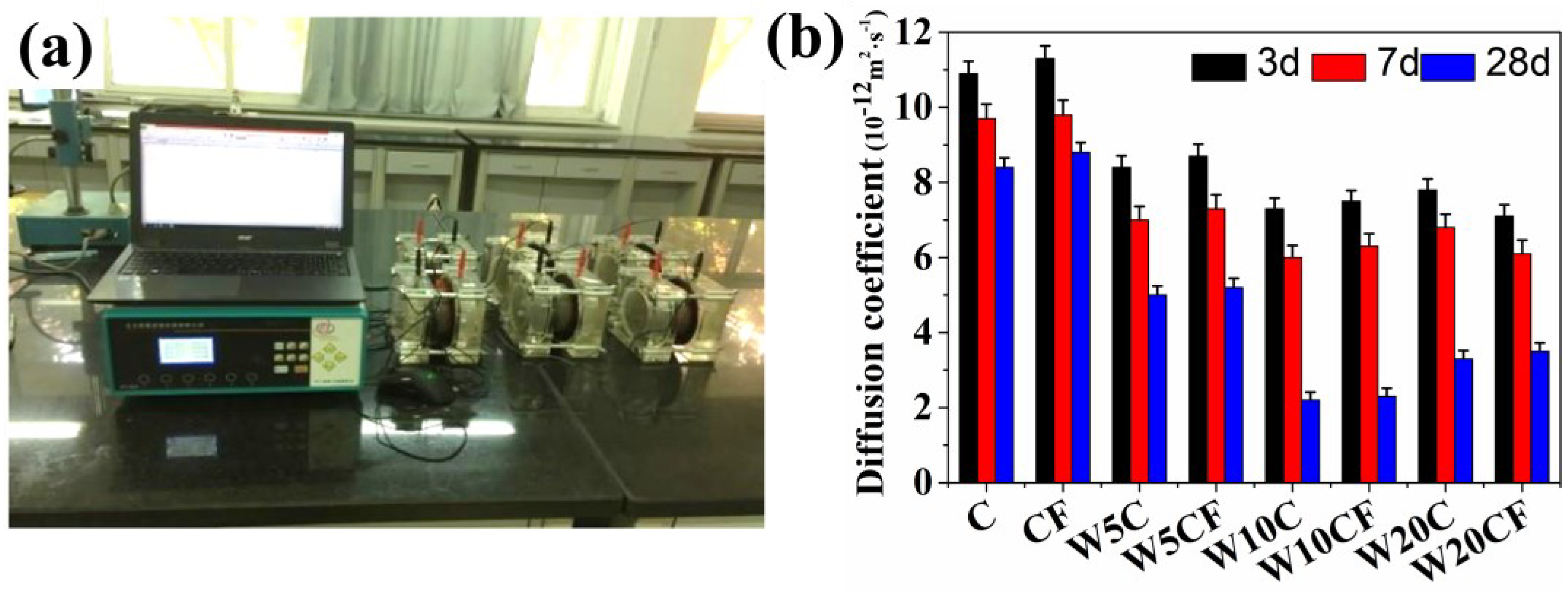

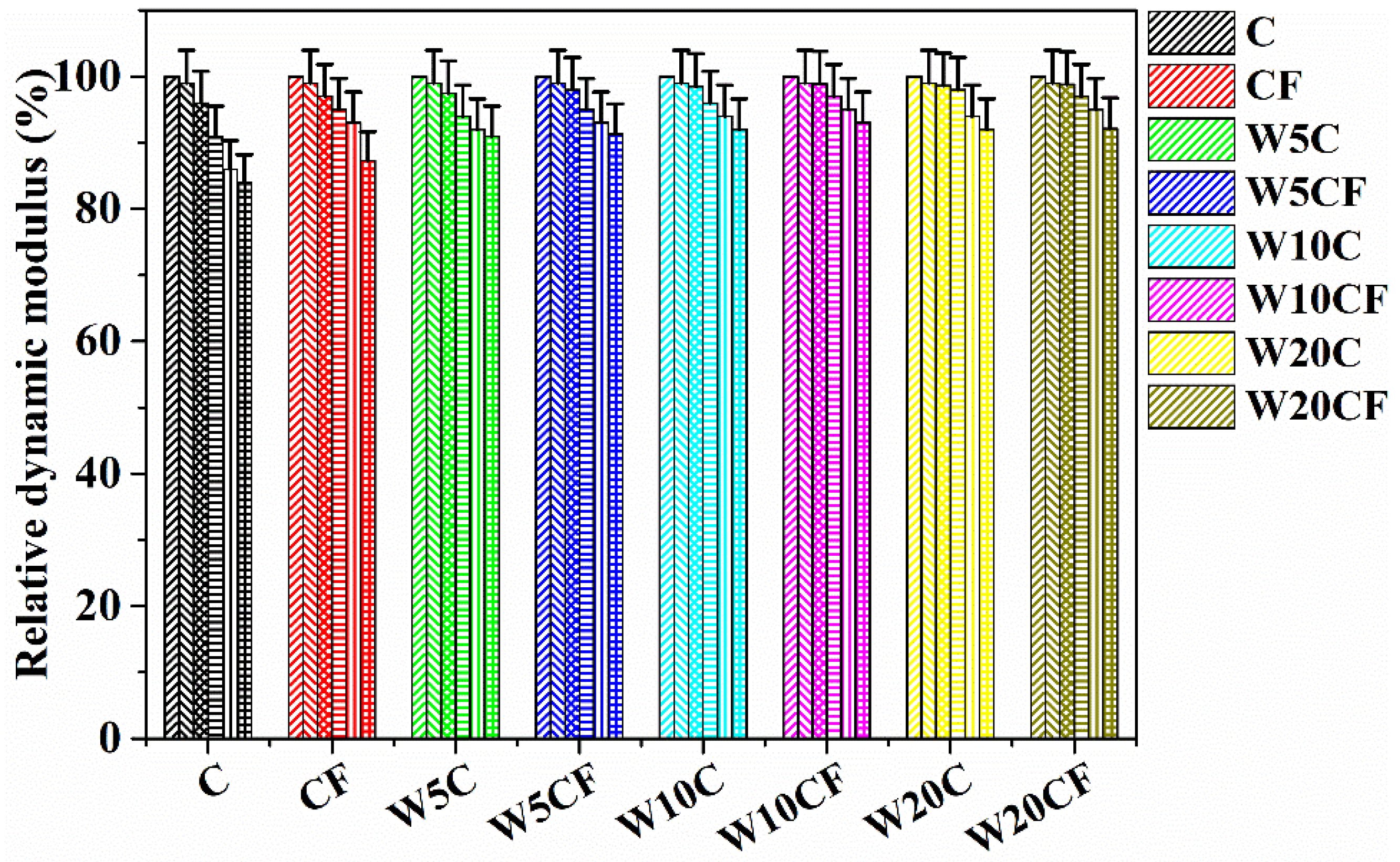

| Items | National Standard | Measured Results |
|---|---|---|
| Fineness (m2·kg−1) | 300 | 360 |
| Initial setting time (min) | ≥45 | 235 |
| Final setting time (min) | ≤600 | 400 |
| Soundness (boiling) (mm) | ≤5 | 2.0 |
| 3 d flexural strength (MPa) | ≥3.5 | 5.0 |
| 28 d flexural strength (MPa) | ≥6.5 | 8.5 |
| 3 d compressive strength (MPa) | ≥17.0 | 19.0 |
| 28 d compressive strength (MPa) | ≥42.5 | 49.5 |
| Filament Diameter (μm) | Tensile Strength (GPa) | Tensile Modulus (GPa) | Carbon Content (%) | Elongation (%) | Density (g·cm3) | Volume Resistivity |
|---|---|---|---|---|---|---|
| 7–10 | 3.57 | 246 | 97 | 1.6 | 1.79 | 35 |
| Indexes | WBE |
|---|---|
| Density (g·cm−3) | 1.25 |
| Solid content (%) | 58 |
| Epoxy equivalent (g/eq) | 215~248 |
| Viscosity (mPa·s) | 2150 |
| Sample | P/C (wt.%) | W/C | Cement (kg/m3) | Sand (kg/m3) | Stone (kg/m3) | Water (kg/m3) | Water Reducer (%) | WBE (kg/m3) | Carbon Fiber (wt.%) |
|---|---|---|---|---|---|---|---|---|---|
| C | 0 | 0.33 | 500 | 650 | 1400 | 165 | 1 | 0 | 0 |
| CF | 1 | ||||||||
| W5C | 5 | 515 | 170 | 25 | 0 | ||||
| W5CF | 1 | ||||||||
| W10C | 10 | 530 | 175 | 53 | 0 | ||||
| W10CF | 1 | ||||||||
| W20C | 20 | 560 | 185 | 112 | 0 | ||||
| W20CF | 1 |
| Sample | Concrete Mass Loss | |||||
|---|---|---|---|---|---|---|
| 0 | 25 | 50 | 100 | 200 | 300 | |
| C | 0 | 0.29 | 0.39 | 0.46 | 0.57 | 0.87 |
| CF | 0 | 0.28 | 0.33 | 0.39 | 0.49 | 0.72 |
| W5C | 0 | 0.23 | 0.29 | 0.37 | 0.47 | 0.66 |
| W5CF | 0 | 0.20 | 0.24 | 0.33 | 0.42 | 0.56 |
| W10C | 0 | 0.08 | 0.15 | 0.19 | 0.23 | 0.25 |
| W10CF | 0 | 0.06 | 0.12 | 0.18 | 0.20 | 0.21 |
| W20C | 0 | 0.16 | 0.24 | 0.28 | 0.33 | 0.39 |
| W20CF | 0 | 0.12 | 0.16 | 0.21 | 0.26 | 0.37 |
| Items | Plain Concrete | Polymer Concrete |
|---|---|---|
| Polymer dosing (%) | 0 | 10 |
| Carbon fiber dosing (%) | 0 | 1 |
| Cost (USD/m3) | 55 | 170 |
| Compressive strength for 28 days (MPa) | 58.2 | 55.4 |
| Flexural strength for 28 days (MPa) | 7.5 | 8.1 |
| Tensile strength (MPa) | 3.58 | 4.76 |
| Bond strength (MPa) | 1.56 | 2.64 |
| Chloride permeation resistance grade | RCM-I | RCM-III |
| Mass loss of freeze–thaw cycles (%) | 0.87 | 0.21 |
| Relative dynamic elastic modulus (%) | 82.14 | 93.86 |
| Drying shrinkage after one year (με) | 530 | 420 |
Disclaimer/Publisher’s Note: The statements, opinions and data contained in all publications are solely those of the individual author(s) and contributor(s) and not of MDPI and/or the editor(s). MDPI and/or the editor(s) disclaim responsibility for any injury to people or property resulting from any ideas, methods, instructions or products referred to in the content. |
© 2023 by the authors. Licensee MDPI, Basel, Switzerland. This article is an open access article distributed under the terms and conditions of the Creative Commons Attribution (CC BY) license (https://creativecommons.org/licenses/by/4.0/).
Share and Cite
Li, Z.; Liu, A.; Gao, D.; Wu, C.; Liu, X.; Zhai, H. Mechanical Performance and Strengthening Mechanism of Polymer Concretes Reinforced with Carbon Nanofiber and Epoxy Resin. Coatings 2023, 13, 1964. https://doi.org/10.3390/coatings13111964
Li Z, Liu A, Gao D, Wu C, Liu X, Zhai H. Mechanical Performance and Strengthening Mechanism of Polymer Concretes Reinforced with Carbon Nanofiber and Epoxy Resin. Coatings. 2023; 13(11):1964. https://doi.org/10.3390/coatings13111964
Chicago/Turabian StyleLi, Zhenfang, Aizhu Liu, Dong Gao, Chuanji Wu, Xin Liu, and Haoran Zhai. 2023. "Mechanical Performance and Strengthening Mechanism of Polymer Concretes Reinforced with Carbon Nanofiber and Epoxy Resin" Coatings 13, no. 11: 1964. https://doi.org/10.3390/coatings13111964





